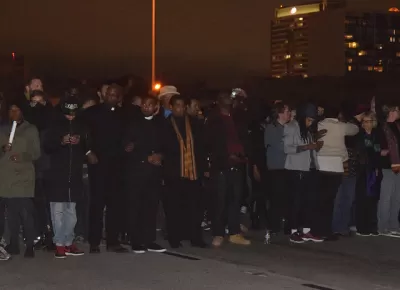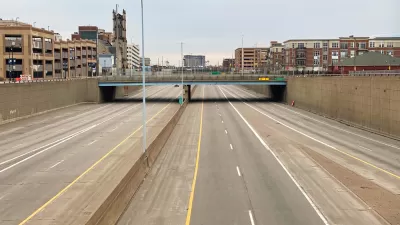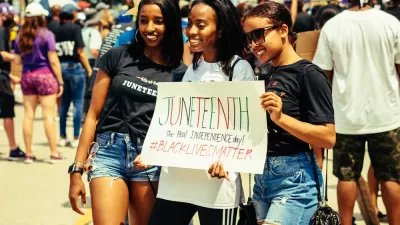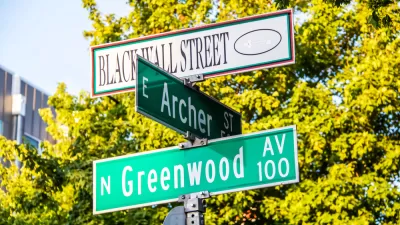Emily Badger, writing for The Washington Post's Wonkblog, doesn't let planners off the hook for the racist history of highway planning around the country.

"As scenes of protest, [highways] are part of the oppression — if also the most disruptive places to call attention to it," writes Emily Badger in a recent article that places 20th century planning at the center of the ongoing cycle of racial conflict gripping the United States.
Recent blockades follow graphic videos showing the deaths of Philando Castile in Falcon Heights, Minnesota and Alton Sterling in Baton Rouge, Louisiana at the hands of police officers. In response, "Protesters in Chicago have blocked Lake Shore Drive. In New York, they've gnarled traffic on the Brooklyn Bridge. In Washington, they've targeted the 14th Street Bridge."
According to Badger, a forthcoming study examined the tendency of Black Lives Matter protestors to stage their protests by shutting down transportation infrastructure:
Researchers at the Rudin Center for Transportation at New York University, in a forthcoming study, counted more than 1,400 protests in nearly 300 U.S. and international cities related to the Black Lives Matter movement from November 2014 through May 2015. Half or more of the protests in that time in Saint Louis, Los Angeles, San Francisco and Oakland, Calif., wound up shutting down transportation infrastructure.
Badger's article responds to a statement by Atlanta Mayor Kasim Reed, who invoked the name of Dr. Martin Luther King Jr. when faced with the prospect of protesters taking over that city's highways: "The only thing I ask is that they not take the freeways. Dr. King would never take a freeway," said Reed.
Badger's response is to document the racist history of highways, and the ongoing consequences suffered by black and minority communities as a result of highways.
The resulting highways were then meant to speed whites who'd moved to the suburbs back and forth to jobs and attractions downtown, leapfrogging minority communities along the way….they still serve this function today. And often, highways that passed through black communities weren't planned with on- and off-ramps to them.
Notice how the word choice of "planned" in the above passage. And now a description of the consequences of that history of planning, which seems strikingly at odds with the intended purposes of contemporary planning purposes.
Even without knowing this history, the consequences of it in cities are evident today, feeding the frustration of communities that have been segregated and separated from schools or parks or prompt ambulance access.
Badger also notes that David Levinson has written a blog post calling for transportation planners to say "Not In Our Name" in response to the use of traffic rules and regulations as a "pretext for enforcing the crime of driving while black."
Now the question is: How far are planners going now to undo the racist mistakes of the past, while making sure they don't happen again?
FULL STORY: Why highways have become the center of civil rights protest

Planetizen Federal Action Tracker
A weekly monitor of how Trump’s orders and actions are impacting planners and planning in America.

Congressman Proposes Bill to Rename DC Metro “Trump Train”
The Make Autorail Great Again Act would withhold federal funding to the system until the Washington Metropolitan Area Transit Authority (WMATA), rebrands as the Washington Metropolitan Authority for Greater Access (WMAGA).

DARTSpace Platform Streamlines Dallas TOD Application Process
The Dallas transit agency hopes a shorter permitting timeline will boost transit-oriented development around rail stations.

Supreme Court Ruling in Pipeline Case Guts Federal Environmental Law
The decision limits the scope of a federal law that mandates extensive environmental impact reviews of energy, infrastructure, and transportation projects.

Texas State Bills to Defund Dallas Transit Die
DART would have seen a 30% service cut, $230M annual losses had the bills survived.

Bikeshare for the Win: Team Pedals to London Cricket Match, Beats Rivals Stuck in Traffic
While their opponents sat in gridlock, England's national cricket team hopped Lime bikes, riding to a 3-0 victory.
Urban Design for Planners 1: Software Tools
This six-course series explores essential urban design concepts using open source software and equips planners with the tools they need to participate fully in the urban design process.
Planning for Universal Design
Learn the tools for implementing Universal Design in planning regulations.
Roanoke Valley-Alleghany Regional Commission
City of Mt Shasta
City of Camden Redevelopment Agency
City of Astoria
Transportation Research & Education Center (TREC) at Portland State University
US High Speed Rail Association
City of Camden Redevelopment Agency
Municipality of Princeton (NJ)





























